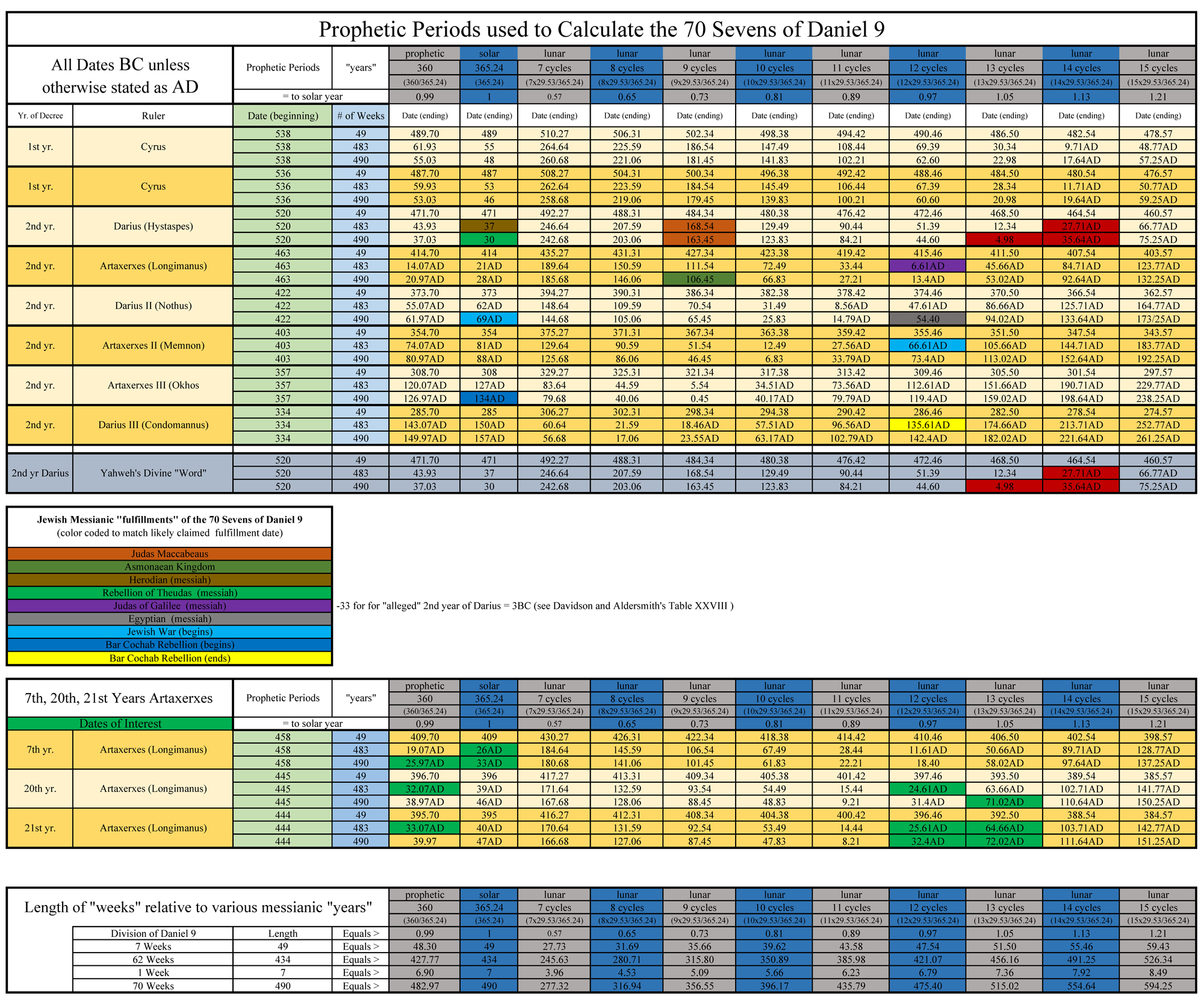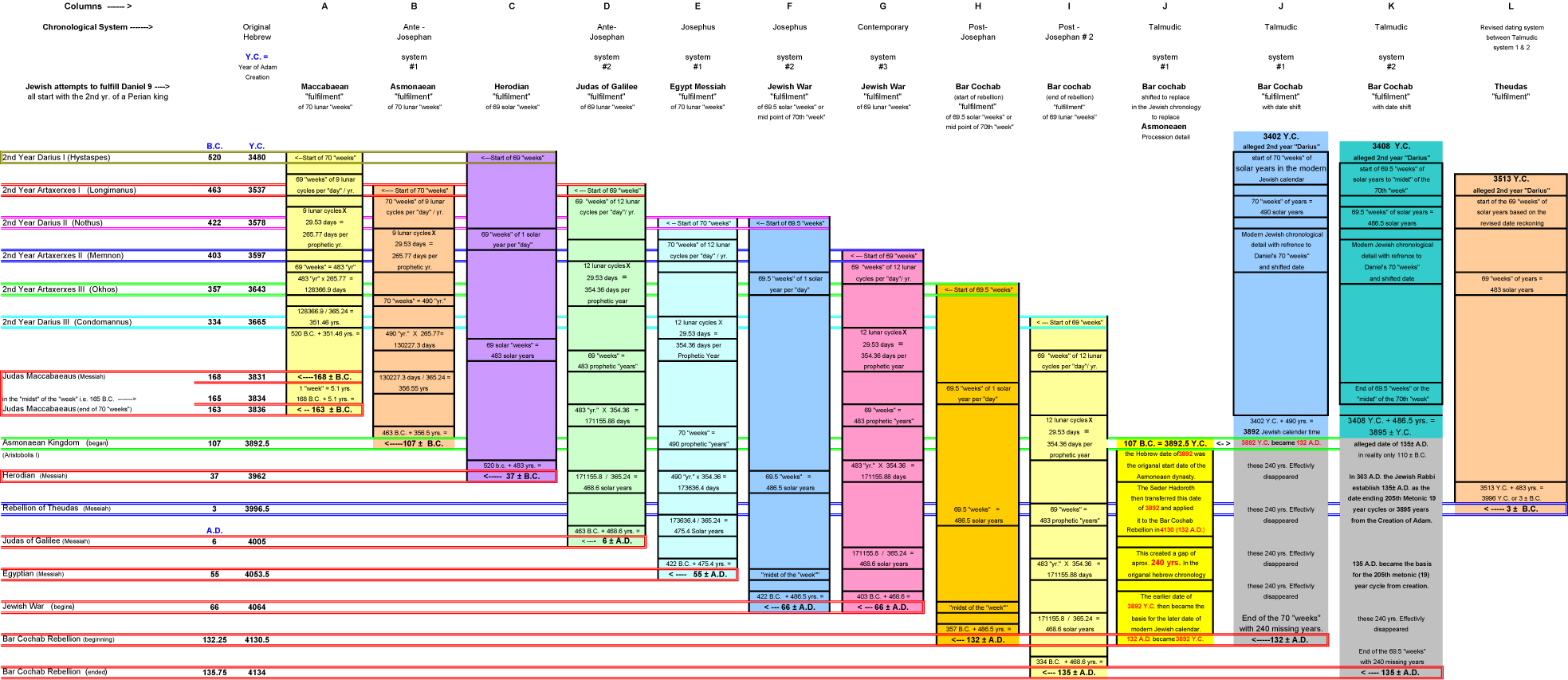 Did you know that Sir Isaac Newton wrote more about Biblical history and Bible prophecy then he did science? While he contributed greatly to science, I would argue that one of his greatest contributions to the field of Biblical history and Bible prophecy was his following observation:
Did you know that Sir Isaac Newton wrote more about Biblical history and Bible prophecy then he did science? While he contributed greatly to science, I would argue that one of his greatest contributions to the field of Biblical history and Bible prophecy was his following observation:
” Those Jews who took Herod for the Messiah, and were thence called Herodians, seem to have grounded their opinion upon the seventy weeks of years, which they found between the Reign of Cyrus and that of Herod: but afterwards, in applying the Prophesy to Theudas, and Judas of Galilee, and at length to Barchochab, they seem to have shortened the Reign of the Kingdom of Persia.” (page 357, Chronology of Ancient Kingdoms Amended)
In this article I hope to also show you why this often ignored statement is a key to understanding the chronology of the Persian era as it relates to the Rabbinic Forgeries Hypothesis. But more importantly this statement provides us a rare insight into the incredible influence Daniel 9 and the Seventy Weeks prophecy has had on Messianic expectancy and Bible chronology of the past and why its unique influence has continued to this very day.
Adding further intrigue to Newton’s statement above is the little known fact that it exposes the root of a chronological error that many of the Jewish messianic expectants of the 1st centuries BC/AD embedded into their interpretation of Daniel 9. Surprisingly, this error has been borrowed by most of today’s Christian eschatological scholars in a well-meaning effort to prove that Yeshua (Jesus) is the Messiah prophesied by the 70 Sevens prophecy of Daniel 9. As you’ll see this error has profound implications for the vast majority of today’s eschatological world views.
Authors Note:
This article is Part III in my exploration of Rabbinic forgery hypothesis. The following links will take you to the previous articles in this series.
Part I: The Septuagint, the Masoretic Text, & Matthew 1
Part II: Matthew 1, the Masoretic Text, & the Bible’s Messianic Symbolism
Part III: The Masoretic Text, Matthew 1, & the Jubilee
Part IV: Sir Isaac Newton, Daniel 9, & the Rabbinic Forgeries Hypothesis
Eclipsing the Persian Era
So what did Newton mean when he stated that Messianic expectancy based in the Seventy Weeks of Daniel 9 “seem” to have shortened the “Reign of the Kingdom of Persia”?
Unfortunately, Newton didn’t provide any direct evidence to explain why it “seems” to him that the Persian era had been shortened by the Jewish Messianic expectants. What’s implied by Newton’s statement, however, is that he believed the Jewish Messianic expectants used the decree of Cyrus (which allowed the Jewish people to rebuild the temple and Jerusalem) as a basis to claim that Herod was a fulfillment of the 70 Weeks of Daniel 9. When the Messianic kingdom (under Herod) failed to materialize, the Jewish Messianic expectants applied the prophecy to Theudas, then Judas of Galilee, and finally Barchochab. Thus by some unexplained means Newton surmised the Jewish rabbis had shortened the chronology of Persia.
Click on Image to Enlarge or for a high resolution PDF click here: PDF

Though Newton’s intuition was amazingly prescient, he provided no mechanism by which he could show how the Jewish people might have used Cyrus’ decree as a means to shorten the Persian period. It wasn’t until the early 1900s that Davidson and Aldersmith1 further illuminated Newton’s insights into a workable theory that could be proven with some clever chronological forensics.
What Davidson and Aldersmith found was that no matter what type of year used; lunar, solar, or prophetic (360 day), there was no reasonable way the Herodians could have used the decree of Cyrus to claim that Herod was the messiah of Daniel 9. To confirm Davidson and Aldersmith’s position, in the chart below, I’ve calculated each of the possible “years” the first century’s Jewish Messianic expectants might have used to claim Herod as the messiah. As you can see none of them provide a means to claim Herod as their messiah.
The following chart includes a “prophetic” (360 day) “year”, a solar (365.24 day) year and varying lunar cycle “years”. Keep in mind here that the Biblical year the Jewish people were familiar with was lunar/solar and varied between 12 & 13 lunar cycles. Please note that since there is some disagreement as to the BC date of Cyrus’ reign (some claim 538 BC and others 536 BC) I’ve provided calculations using both.
Click on Image to Enlarge or for a high resolution PDF click here: PDF
As you can see from the above chart, while Newton was on the right trail regarding the shortened Persian period attributed to the messianic expectations of the Jewish people, it was not the decree of Cyrus that was the basis for their messianic expectancy, but rather a decree given in 2nd year of Darius.
Davidson and Aldersmith explained Newton’s error this way:
“Thus Sir Isaac Newton (‘ Chronology of Ancient. Kingdoms Amended,” p. 357) states correctly, regarding the manipulations of the Jews, but incorrectly regarding the 1st year of Cyrus as the basis of these manipulations” (Davidson & Aldersmith, The Great Pyramid: It’s Divine Messiah – Table XXVIII)
What Davidson & Aldersmith discovered was that a decree in the 2nd year of Darius (Hystaspes) also known as Darius ‘the great’ Artaxerxes, did indeed provided a basis for the Herodians to claim that Herod was the expect messiah. Not only did this decree in the 2nd year of Darius provide the Herodians a basis to claim that Herod was the Messiah, but when Herod failed to usher in the messianic kingdom, the Jewish Messianic expectants found in this decree, the means to apply it to the 2nd year of the next Persian king and thus claim a new messianic hero as the expected Messiah. In fact, as the chart above demonstrates the 2nd year of Darius provided a basis for all the Jewish messianic claims of the 1st centuries BC/AD. That basis found its origins in the following statement from the book of Ezra:
And the elders of the Jews builded, and they prospered through the prophesying of Haggai the prophet and Zechariah the son of Iddo. And they builded, and finished it, according to the commandment of the God of Israel, and according to the commandment of Cyrus, and Darius, and [even] Artaxerxes king of Persia. (Ezra 6:14)
If you read the entire context of Ezra chapter 6 you’ll find that verse 14 is a statement which provided the Jewish people with a rock solid starting point from which to build their messianic claims. That starting point originated from Yahweh Himself when He gave a divine decree to restore and build Jerusalem. This decree had further weight because it was given through and confirmed by the – two – prophetic proclamations of Haggai and Zechariah.
Click on Image to Enlarge or for a high resolution PDF click here: PDF
This divine “commandment” (Hebrew dabar) was given by Yahweh through Haggai and Zechariah in the 2nd year of Darius(See Ezra 6, Hag. 1 & Zech. 1). Because this divine command was given in the 2nd year of a Persian king named Darius, the Jewish Messianic expectants of the 1st centuries BC/AD, found in this 2nd year a basis for their calculations to prove their heroes were the expected messiah. As we’ll see this 2nd year of Darius became the origin of all the 2nd temple chronological confusion which has plagued Bible chronologists and eschatologists (both Jewish & Christian) to this very day.
A Divine Word to Restore and Build
Before expanding upon the chronological errors resulting from the Jewish application of the 2nd year of Darius as a basis for their messianic fulfillment attempts, we really need to understand the context of Ezra 6:14 and the “commandment” Ezra describes as given by the “God of Israel”.
Did you know that in Daniel 9:25 the word translated “commandment” is the Hebrew word dabar? Interestingly, dabar simply means – “word”. According to my concordance, dabar is used 1439 times in the Bible. Of those occurrences, the vast majority refer to the “word of Yahweh”. That bears repeating, the vast majority of the time dabar (word) is used in the Bible refers to something spoken by Yahweh, the living God of the Bible.
Know therefore and understand, that from the going forth of the commandment [commandment = dabar = word] to restore and to build Jerusalem unto the Messiah the Prince shall be seven weeks,… (Daniel 9:25a)
It is only reasonable to consider that to the 1st century Jewish Messianic expectants, it is likely that their first and natural choice would have been to assume that the “word” (dabar) of Daniel 9:25 was the word of Yahweh. What baffles me is that today most Christian scholars go to such great lengths to “prove” a decree of Cyrus, Darius, or Artaxerxes, but you hardly ever hear about the commandment or “word” of Yahweh.
This blindness is even more unexplainable when you consider that in Daniel 9 dabar is used not just once (in Daniel 9:25) but three other times in the preceding verses. Each of those other occurrences refers clearly to the dabar or word of Yahweh. Here take a look for yourself:
Daniel 9:2 – In the first year of his reign I Daniel understood by books the number of the years, whereof the word [dabar] of YHWH came to Jeremiah the prophet, that he would accomplish seventy years in the desolations of Jerusalem.
Daniel 9:12 – And he [YHWH] hath confirmed his words [dabar], which he spake against us, and against our judges that judged us, by bringing upon us a great evil: for under the whole heaven hath not been done as hath been done upon Jerusalem.
Daniel 9:23 – At the beginning of thy supplications the commandment [word / dabar] came forth, and I am come to shew thee; for thou art greatly beloved: therefore understand the matter, and consider the vision.
Daniel 9:25 – Know therefore and understand, that from the going forth of the commandment [word / dabar] to restore and to build Jerusalem unto the Messiah the Prince shall be seven weeks,
Can you explain to me why nearly all Christian scholars today completely ignore this context when ascertaining who gave the “word” to restore and build Jerusalem? Why is it not even mentioned?
This blindness aside, as you can see from the above verses, there is in fact real hard contextual evidence, to consider that Daniel 9:25 might have been a divine “word” to restore and build Jerusalem. Here are the two contextual examples of Yahweh’s divine word to restore and build Jerusalem as described in Ezra 6:14. Both were given in the 2nd year of Darius:
In the second year of Darius the king, in the sixth month, in the first day of the month, came the word [dabar] of YHWH by Haggai the prophet …
This people say, The time is not come, the time that YHWH’s house should be built. Then came the word [dabar] of YHWH by Haggai the prophet, saying, Is it time for you, O ye, to dwell in your cieled houses, and this house lie waste?…
Thus saith YHWH of hosts; Consider your ways. Go up to the mountain, and bring wood, and build the house; and I will take pleasure in it, and I will be glorified, saith YHWH. (Haggai 1:1-8 exerpted)
Upon the four and twentieth day of the eleventh month, which is the month Sebat, in the second year of Darius, came the word [dabar] of YHWH unto Zechariah….
Then the angel of YHWH answered and said, O YHWH of hosts, how long wilt thou not have mercy on Jerusalem and on the cities of Judah, against which thou hast had indignation these threescore and ten years?…[70 years from the departure of the shekinah from the 1st temple, i.e. 589 – 520 BC ]
And YHWH answered the angel that talked with me with good words and comfortable words. So the angel that communed with me said unto me, Cry thou, saying, Thus saith YHWH of hosts; I am jealous for Jerusalem and for Zion with a great jealousy. And I am very sore displeased with the heathen that are at ease: for I was but a little displeased, and they helped forward the affliction.
Therefore thus saith YHWH; I am returned to Jerusalem with mercies: my house shall be built in it, saith YHWH of hosts, and a line shall be stretched forth upon Jerusalem. (Zechariah 1:7-16 exerpted)
And the elders of the Jews builded, and they prospered through the prophesying of Haggai the prophet and Zechariah the son of Iddo. And they builded, and finished it, according to the commandment of the God of Israel, and according to the commandment of Cyrus, and Darius, and [even] Artaxerxes king of Persia. (Ezra 6:14)
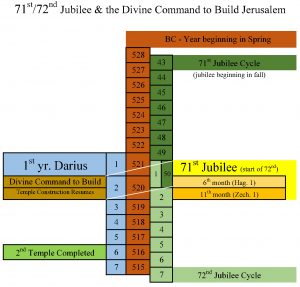 So with this in mind, we now have a better understanding of why the Jewish Messianic expectants of the first centuries BC/AD would have seen in Daniel 9:25 a divine decree to restore and build Jerusalem. Further, since both Haggai and Zechariah witnessed this decree as originating in the 2nd year of Darius (‘the great’ Artaxerxes) then naturally the Jewish Messianic expectants would have used this 2nd year of Darius (520 BC) as their basis to calculate the fulfillment of 70 “Weeks” in their messianic heroes. Keep in mind here that this date (520 BC) also marked the end of 70 years of divine anger mentioned in Zechariah 1 as well as the 71st jubilee cycle from Adam as we explored in my last article: The Masoretic Text, Matthew 1, & the Jubilee
So with this in mind, we now have a better understanding of why the Jewish Messianic expectants of the first centuries BC/AD would have seen in Daniel 9:25 a divine decree to restore and build Jerusalem. Further, since both Haggai and Zechariah witnessed this decree as originating in the 2nd year of Darius (‘the great’ Artaxerxes) then naturally the Jewish Messianic expectants would have used this 2nd year of Darius (520 BC) as their basis to calculate the fulfillment of 70 “Weeks” in their messianic heroes. Keep in mind here that this date (520 BC) also marked the end of 70 years of divine anger mentioned in Zechariah 1 as well as the 71st jubilee cycle from Adam as we explored in my last article: The Masoretic Text, Matthew 1, & the Jubilee
Building Jerusalem
I’m sure some of you are thinking, okay I get that, but this still doesn’t really explain the mechanics of how or why the Jewish Messianic expectants justified applying this 2nd year basis to other Persian kings and thus “eclipsing” the Persian period nor does it really explain the resulting chronological confusion which resulted in this shortening of the Persian era. That explanation is found in a further examination of Ezra 6:14 and a related bit of intriguing Hebrew grammar.
You see at the center of the Jewish people’s efforts to “restore” Jerusalem was their effort to rebuild Yahweh’s desolate sanctuary. Building the temple in the eyes of the Jewish people was restoring Jerusalem. Try to put yourself in 2nd temple era context. What made Jerusalem different from any other city in the history of mankind? It was different, because it is the one place where Yahweh choose to meet with mankind.
You know, I find our obtuseness about this mind boggling. When we look for the “commandment to restore and build Jerusalem” of Daniel 9:25 most scholars will tell you it was the walls, the plaza, or even the houses of Jerusalem that signified the building of Jerusalem.
Why?
We don’t get that assumption from Daniel 9:25. So why the insistence upon the walls or plaza of Jerusalem as the starting point of the Jewish people’s efforts to rebuilt Jerusalem. Is Jerusalem as special city because of its impressive walls? Its dwellings?
No, Jerusalem was unique because it was the temporary dwelling place of Yahweh. Even the enemies of the Jewish people understood this.
I encourage you to read Ezra 4 carefully. You’ll find that when the enemies of the Jewish people approached the king of Persia about the Jewish building efforts they claimed it was the walls and fortifications they were concerned about. But notice when they received their cease and desist from the king it was the temple construction which they halted.
Be it known unto the king, that the Jews which came up from thee to us are come unto Jerusalem, building the rebellious and the bad city, and have set up the walls thereof, and joined the foundations. Be it known now unto the king, that, if this city be builded, and the walls set up again, then will they not pay toll, tribute, and custom, and so thou shalt endamage the revenue of the kings…
Then sent the king an answer unto Rehum the chancellor, and to Shimshai the scribe, and to the rest of their companions that dwell in Samaria,..
Give ye now commandment to cause these men to cease, and that this city be not builded, until another commandment shall be given from me…
Now when the copy of king Artaxerxes’ letter was read before Rehum, and Shimshai the scribe, and their companions, they went up in haste to Jerusalem unto the Jews, and made them to cease by force and power.
Then ceased the work of the house of God which is at Jerusalem. So it ceased unto the second year of the reign of Darius king of Persia. (Ezra 4:12-24 exerpted)
As you can see from the above account building the temple was in fact building Jerusalem.
Another example comes from the context of Daniel 9. When Daniel poured out his heart to Yahweh in prayer and supplication regarding his people and the city of Jerusalem (Dan. 9:1-22), what was the focus of his pleadings? From Daniel’s point of view what was restoring Jerusalem?
In Daniel’s mind was restoring Jerusalem about the wall? We can’t separate Daniel 9:25 from the context of Daniel’s prayer. And yet, that is what nearly every scholar today must do in order to find a secular decree to restore and build Jerusalem and its walls.
Here are Daniel’s pleadings to Yahweh, notice his focus:
O Lord, according to all thy righteousness, I beseech thee, let thine anger and thy fury be turned away from thy city Jerusalem, thy holy mountain: because for our sins, and for the iniquities of our fathers, Jerusalem and thy people are become a reproach to all that are about us.
Now therefore, O our God, hear the prayer of thy servant, and his supplications, and cause thy face to shine upon thy sanctuary that is desolate, for the Lord’s sake. (Daniel 9:16-17)
 Darius
Darius and even Artaxerxes
This brings us back to Ezra 6:14-15 and the restoration of the temple. It was this “building” effort that was considered by all parties, (the enemies of the Jews, Daniel, Ezra, and Yahweh) the de facto event in restoring or building Jerusalem. As Ezra 6:14-15 summarizes, it was, an order of importance, the “commandment” of Yahweh, Cyrus, Darius, and Artaxerxes that brought to completion the restoration of the temple by the 6th year of Darius. Just as the destruction of Solomon’s temple marked the desolation of Jerusalem so too the rebuilding of the 2nd temple marked Jerusalem’s restoration. The temple of Yahweh was the beating heart of Jerusalem.
I can’t stress enough how important this context is, because this is where most of today’s reasonably minded scholars break nearly all well established rules of exegesis. The most reasonable reading of Ezra chapters 1-6 clearly delineates the chronology of the temple construction as being completed by the 6th year of Darius (‘the great’ Artaxerxes). Here take a look once more:
And the elders of the Jews builded, and they prospered through the prophesying of Haggai the prophet and Zechariah the son of Iddo. And they builded, and finished it, according to the commandment of the God of Israel, and according to the commandment of Cyrus, and Darius, and [even] Artaxerxes king of Persia.
And this house was finished on the third day of the month Adar, which was in the sixth year of the reign of Darius the king. (Ezra 6:14-15)
Because of the way this verse has been translated, when you and I read the above account in English we assume that there were four individuals who gave a “commandment” to restore and build the temple. But in Hebrew this is just one of two different ways to understand the verse.
A Jewish person, who understood the context of Ezra chapters 1-6 and understood Hebrew grammar would have more than likely (as their historical messianic attempts demonstrate) understood that “Artaxerxes” did not refer to another Persian ruler but rather referred to Darius as an “Artaxerxes”.
Again the context:
A careful reading of Ezra chapters 1-6 makes it clear, that only Yahweh, Cyrus, and Darius gave “commandments” which resulted in the completion of the temple by the 6th year of Darius. The Bible simply does not tell of another “Artaxerxes” responsible for the completion of the temple by the 6th year of Darius. No such person exits!
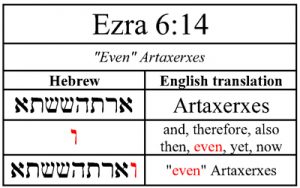 This is where Hebrew grammar explains the confusion. In Hebrew, the letter “waw’ is normally used as a conjunction. But sometimes, as any Hebrew lexicon will tell you, “waw” is also used as a hendiadys or in other words, instead of connecting two words with two different meanings, it is used to connect two words with the same meaning. The TWOT Hebrew lexicon explains it this way:
This is where Hebrew grammar explains the confusion. In Hebrew, the letter “waw’ is normally used as a conjunction. But sometimes, as any Hebrew lexicon will tell you, “waw” is also used as a hendiadys or in other words, instead of connecting two words with two different meanings, it is used to connect two words with the same meaning. The TWOT Hebrew lexicon explains it this way:
519.0 – w (wa) . . . and, so, then, when, now, or, but, that and many others.
(ASV and RSV similar.) The vocalization varies.
This is an inseparable prefix which is used as a conjunction or introductory particle which can usually be translated “and.”
The fundamental use of the prefix is that of a simple conjunction “and,” connecting words (“days and years,” Gen. 1:14), phrases (“and to divide” Gen. 1:18) and complete sentences (connecting Gen. 2:11 with verse 12). However it is used more often and for a greater variety of construction than is the English connector “and.”
It is often used at the beginning of sentences, for which reason the KJV begins many sentences with an unexplained “and.” This use may be explained as a mild introductory particle and is often translated “now” as in Exo 1:1 where it begins the book (KJV, ASV; the RSV ignores it completely; cf. Gen 3:1; Gen 4:1).
The item following the prefix is not always an additional item, different from that which preceded: “Judah and Jerusalem” (Isa. 1:1), pointing out Jerusalem especially as an important and representative part of Judah; “in Ramah, and his own city” (1 Sam 28:3), the two being the same place, hence the translation “even” as explanatory.
When the second word specifies the first the construction is called a “hendiadys,” i.e., two words with one meaning. For example, “a tent and dwelling” in 2 Sam 7:6 means “a dwelling tent.” (TWOT 519.0, emphasis mine)
So in Ezra 6:14 when the passage refers to Darius and Artaxerxes, the only reasonable contextual explanation demands that we translate the passage as “Darius and even Artaxerxes.” In other words Ezra 6:14 was not telling of a fourth Persian king who gave a “commandment” to restore and build Jerusalem, it was simply informing us of the fact that the Persian king named “Darius” was also known by the title “Artaxerxes”. As I explained in my article Context, Chronology, and Daniel 9, this additional title can be explained with reasonable historical facts related to Darius’ rise to power in Persia. This straight forward contextual chronology also explains why Ezra 6 ends in the 6th year of Darius “even” Artaxerxes and Ezra 7 picks the story back up in the 7th year of Artaxerxes (a.k.a Darius)
Necessity – the Mother of Invention
This then brings new light to the chronological confusion of the Persian era and has direct bearing on the Jewish forgeries hypothesis. As stated before, the Jewish Messianic expectants of the first centuries BC/AD were certainly justified in believing that there was a divine “commandment” (word) to restore and build Jerusalem given in the 2nd year of Darius ‘the great’ Artaxerxes. This divine command was further strengthened by the fact that it was given through two different prophets in the same year. (the 2nd year of Darius – see Hag. 1 & Zech. 1)
The statement of Ezra 6:14 that equated Darius with Artaxerxes then became the chronological basis to “eclipse” the Persian era.
As Davidson and Aldersmith showed, (and my chart calculations above reflect) using the 2nd year of Darius as a basis, Jewish Messianic expectants had a mathematical means to claimed the Maccabaes fulfilled the 70 “weeks” of Daniel 9. When Maccabaen fulfillment didn’t usher in the messianic age then the prophecy was recycled and applied to Asmonaeans, then the Herodeans, and on down the line. Each time the prophecy was recycled it still had as its basis the implied “divine commandment” to restore and build Jerusalem in the 2nd year of Darius. (The only real “commandment” choice in the eyes of the Jewish people) But since Ezra 6:14 equated Darius with Artaxerxes this allowed the Messianic expectants to shift the prophecy to successive Darius and Artaxerxes of the Persian era, each time clipping a bit of history from the Persian era. Thus the original divine decree in 520 BC became a divine decree given in 463 BC, then 422 BC, then 403 BC, etc, etc. Messianic necessity became the mother of chronological invention.
Click on image to enlarge or to view a high resolution PDF click here: PDF

Thus the divine “command” in the 2nd year of Darius, and the Biblical statement that Darius was also kwon as Artaxerxes became the vehicle by which the Jewish people gradually erased much of the Persian era. To give you a better sense of this chronology, below is a chart based upon Aldersmith and Davidson’s original. I’ve modified the first chart to include the BC dating and added color for clarification. Davidson and Aldersmith’s dating is based upon what they termed A.K. (anno Kalendri) which began with first year of Adam as described in the Masoretic text.
The second chart I’ve provided shows the same basic chronology only expanded and from a slightly different perspective. The charts are quite large so I recommend you click on the image to get a larger resolution chart or download the PDF. I’ve also provided my Excel workbook with notes and calculations (at the end of this article) for those of you who are really serious about digging into this subject and verifying my work.
As you explore these charts take note of a few things.
• First, notice how profoundly influential Daniel 9 and the 70 “Weeks” have been to the Messianic identity of the Jewish people.
• Second, notice (I will expand on this later) how Daniel 9 and the failed messianic applications of this prophecy provide unique evidence for the existence of the shorter Hebrew chronology based in the Masoretic text.
• Third, notice how each successive Persian Darius or “Artaxerxes” became the catalyst to shorten the Persian period.
Click on image to enlarge or for higher resolution PDF click here: PDF
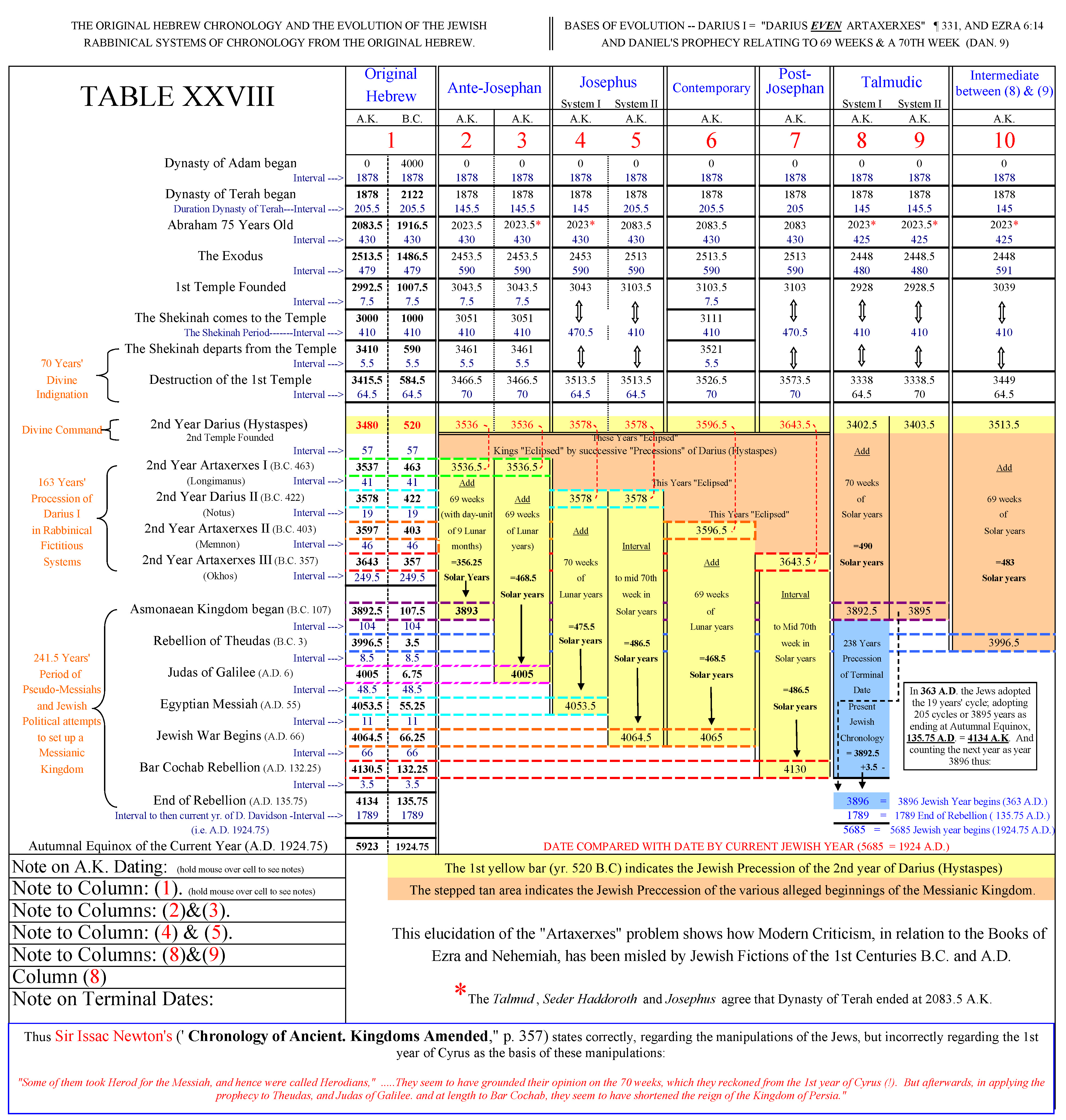
Click on image to enlarge or for higher resolution PDF click here: PDF
Unproven Accusations
For those of you who have taken a bit of time to study the charts, you can see in the chronological forensics described above a reasonable explanation of why the Jewish people eclipsed the Persian period. To be sure Rabbinic scholars have had no great motivation to correct their errors, especially in light of the adversarial relationship Jews and Christians have showed towards each other over the centuries, but no longer can we claim with certainty that the rabbis forged Persian history to obfuscate the identity of Yeshua as the promised Messiah. Frankly, it’s much more complicated and likely less nefarious than that.
Further, those well-meaning scholars like Jeremy Sexton and Henry Smith who use evidence of this erroneous Rabbinic chronology of the Persian era as a means to give credence to their Rabbinic Forgeries Hypothesis of the OT Masoretic text, I’d encourage to take a step back and reevaluate any related assumptions.
An Artaxerxes Assumption
More importantly though, I call out my Christian peers who in self-righteous indignation point to the chronological errors of the Jewish rabbis, claiming they were intentionally used to discredit Yeshua (Jesus) as the promised Messiah, but themselves borrow the very same chronological errors to prove their own Messianic expectations about Yeshua.
Think about the irony of the situation. Most of today’s respected eschatological teachers, historians, and scholars claim that “commandment to restore and build Jerusalem” of Daniel 9:25 was given by Artaxerxes Longimanus in his 7th or 21st year (i.e.. 458 or 445 BC respectively) Yet, as you’ve seen described in this article the very basis for those claims come from the evolution of the Jewish chronology, (which said chronology erroneously manipulated the Biblical statement of Ezra 6:14 that Darius “even” Artaxerxes was the Persian ruler during whose reign when the divine decree was given) so that they (the Jewish people) could claim their own Messianic heroes were the promised Messiah.
Not only do most Christian scholars today follow in the erroneous footsteps of their Jewish predecessors (by claiming that the “Artaxerxes” of Ezra 6 & 7 is Longimanus) but they compound this error by jettisoning the original kernel of truth that provided the basis for the entire complicated mess in the first place. That original kernel of truth being the certain knowledge that Daniel 9 and 70 “weeks” prophecy began with a divine command to restore and build Jerusalem by Yahweh the living God of the Bible.
Why This is Important
If you’ve read this far I hope you don’t think this subject is some trivial exercise irrelevant chronological minutia. If you believe as I do, that many Biblical vectors are pointing towards the soon return of Yeshua then we need to ensure that our eschatological world view is based upon a rock solid foundation. Whether you realize it or not, Daniel 9 and the 70 “Weeks” prophecy is the core of most of your future eschatological framework. This prophecy influences our view of the Anti-Christ and his kingdom, a “seven year” tribulation, the rapture, the restoration of Israel, the end of this age, and many other important eschatological truths.
If you doubt my statement, here is an exercise for you: Try explaining a “seven year” tribulation without the prophetic context of Daniel 9. Try to find a single clear statement in the Bible which mentions a 7 year period of tribulation. Other periods of time are mentioned, 42 months, 1260 days, 1335 days, etc, but not seven years. Without an Artaxerxes Assumption, the seven year tribulation theory loses its chronological anchor point and its credibility.
How many books have you read that lay out their case for the rapture, (pre trib, post trib, mid trib, pre-wrath) using a 7 year tribulation as the framework? Nearly all of them, don’t they? Do you see how deep this root of error has grown into our view of eschatology?
If your view of Daniel 9 and the 70 “Weeks” includes some form of the original Jewish Artaxerxes Assumption then it most likely rests upon a unstable foundation of sand. Any understanding of Bible prophecy that relies in part or whole upon an interpretation Daniel 9 needs to be reconsidered carefully to ascertain how they have been influenced by Daniel 9. We may be soon entering into one of the most challenging and wonderful periods in human history and your view of how the Bible says those events are supposed to play out may be flawed. If you are a pastor or a Bible teacher, you may be giving erroneous information to your followers. Today I plead with you to ensure your interpretations of Bible prophecy are based upon rock solid, contextual Biblical truth. If you sincerely care about truth, then I encourage you to do your Berean duty and carefully consider the chronology of the 2nd temple era. Challenge yourself to apply the golden rule of Biblical interpretation to your assumptions about Artaxerxes and “word” to restore and build Jerusalem.
The Purpose of Prophecy and Chronology
As a final thought, I believe it is important to always remember why Bible chronology and Bible prophecy are important. Revelation 19:10 informs us that the “spirit” of prophecy is the testimony of Yeshua. In other words, the underlying theme of the Bible’s prophetic revelation is the testimony of Yahweh’s salvation for mankind. (Yeshua (Jesus) means Yahweh saves or Yahweh’s salvation).
Prophecy is a prediction of future events. Those events, in order to have relevance to you and I, are related within a framework of time. In my opinion, this is the reason the Bible’s chronological details are so important. They are the context that brings relevance to Yahweh’s redemptive plan for mankind. The main purpose of Bible chronology is not about aligning Biblical history with what modern scholarship says about the geological or archeological record, any more than the main purpose of Bible prophecy is about predicting future events.
The real purpose of prophecy and chronology in the Bible (in my opinion) is to work hand in hand to provide mankind with evidence and assurance that Yahweh is in control, that He has ordered the past, is working in the present, and is in complete control of the future to accomplish His redemptive purpose for mankind through His Yeshua. That is the real importance of the Bible’s chronological and prophetic record. As you explore these issues in the coming days I hope you’ll keep that focus in mind.
Maranatha!
My Excel workbook with calculations and notes: Excel Workbook
1Author’s Note on the Rabbinic Forgeries Hypothesis:
For those of you really interested in a further detailed analysis of Josephus’ chronology as it relates to the original Hebrew chronology and the Masoretic text I’ve provided Davidson and Aldersmith’s charts and notes on the subject. The charts and notes come from their book The Great Pyramid: It’s Divine Message (1924). Though I don’t agree with all of Davidson’s and Aldersmith’s theories about the Great Pyramid, in my 30 plus years of interest in Biblical history and Bible prophecy I’ve not found a more comprehensive organization and elucidation of Ancient and Biblical history as found in their 570 page tome.
Those of you interested in the Rabbinic forgeries hypotheses will also find in Davidson’s and Aldersmith’s unique work, evidence to show that 1st and 2nd BC century messianic expectants did indeed use a version of Old Testament chronology which is congruent with the Masoretic text today. Their work disproves the theory that the chronology of the Masoretic text was a 1st or 2nd century AD invention of Jewish rabbis. There Elucidation of the subject can be found here:
Chronological Forensics of the Original Hebrew Chronology
Authors Note:
This article is Part III in my exploration of Rabbinic forgery hypothesis. The following links will take you to the previous articles in this series.
Part I: The Septuagint, the Masoretic Text, & Matthew 1
Part II: Matthew 1, the Masoretic Text, & the Bible’s Messianic Symbolism
Part III: The Masoretic Text, Matthew 1, & the Jubilee
Part IV: Sir Isaac Newton, Daniel 9, & the Rabbinic Forgeries Hypothesis
* * *

